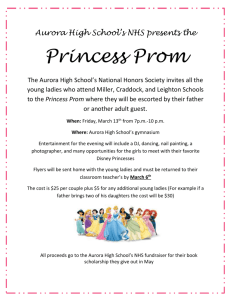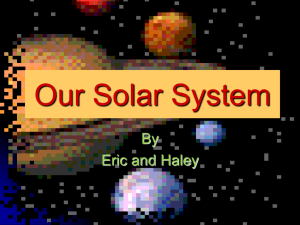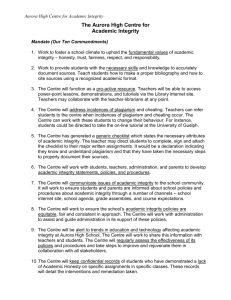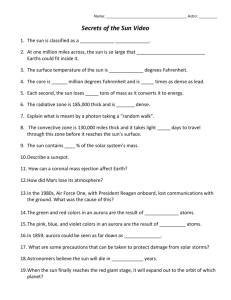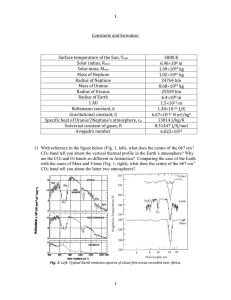IOPW Steering Committee Meeting, November 11, 2014 Attending:
advertisement
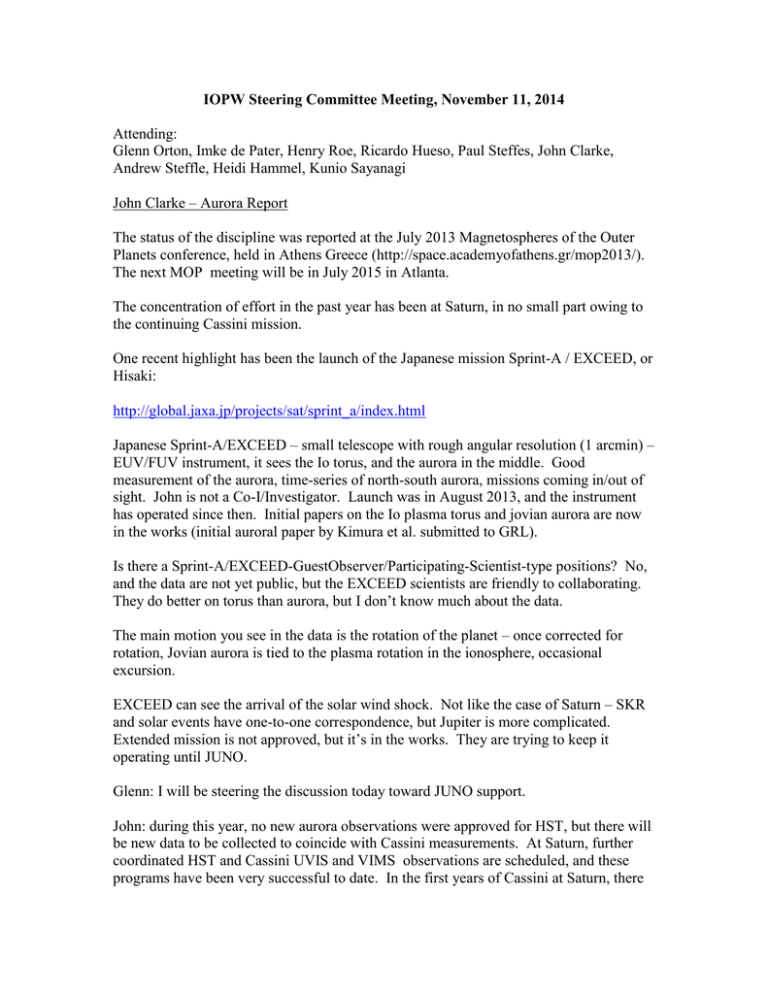
IOPW Steering Committee Meeting, November 11, 2014 Attending: Glenn Orton, Imke de Pater, Henry Roe, Ricardo Hueso, Paul Steffes, John Clarke, Andrew Steffle, Heidi Hammel, Kunio Sayanagi John Clarke – Aurora Report The status of the discipline was reported at the July 2013 Magnetospheres of the Outer Planets conference, held in Athens Greece (http://space.academyofathens.gr/mop2013/). The next MOP meeting will be in July 2015 in Atlanta. The concentration of effort in the past year has been at Saturn, in no small part owing to the continuing Cassini mission. One recent highlight has been the launch of the Japanese mission Sprint-A / EXCEED, or Hisaki: http://global.jaxa.jp/projects/sat/sprint_a/index.html Japanese Sprint-A/EXCEED – small telescope with rough angular resolution (1 arcmin) – EUV/FUV instrument, it sees the Io torus, and the aurora in the middle. Good measurement of the aurora, time-series of north-south aurora, missions coming in/out of sight. John is not a Co-I/Investigator. Launch was in August 2013, and the instrument has operated since then. Initial papers on the Io plasma torus and jovian aurora are now in the works (initial auroral paper by Kimura et al. submitted to GRL). Is there a Sprint-A/EXCEED-GuestObserver/Participating-Scientist-type positions? No, and the data are not yet public, but the EXCEED scientists are friendly to collaborating. They do better on torus than aurora, but I don’t know much about the data. The main motion you see in the data is the rotation of the planet – once corrected for rotation, Jovian aurora is tied to the plasma rotation in the ionosphere, occasional excursion. EXCEED can see the arrival of the solar wind shock. Not like the case of Saturn – SKR and solar events have one-to-one correspondence, but Jupiter is more complicated. Extended mission is not approved, but it’s in the works. They are trying to keep it operating until JUNO. Glenn: I will be steering the discussion today toward JUNO support. John: during this year, no new aurora observations were approved for HST, but there will be new data to be collected to coincide with Cassini measurements. At Saturn, further coordinated HST and Cassini UVIS and VIMS observations are scheduled, and these programs have been very successful to date. In the first years of Cassini at Saturn, there were few UV/IR observations of the aurora, but the number has been increasing over the years, and is now a common mode for Cassini: http://www.astronomynow.com/news/n0911/25cassini/ The lead people are Jon Nichols for the HST, Wayne Pryor for UVIS, and Tom Stallard for VIMS. The detection of auroral emission from the magnetic footprint of Enceladus at Saturn was a big event a couple of years ago. For the present cycle of HST, unfortunately there were no new auroral programs accepted. People are already planning proposals for the next round of HST. New observations of Uranus aurora – there’s been one observation that was kind of (but not really) clear (by IUE), and other that was hard to believe. Uranus is a tough case. Uranus is headed toward a B-field configuration that will allow bright aurora. Henry: Planetary gets so little time per proposal – often, smaller proposing teams work together to merge the effort. Andy: the aurora community tends to have everyone proposing together and not have anybody available as reviewers. John: best strategy is to designate two persons not taking part in any HST mission so that they are available as reviewers. Glenn: what’s the cadence? John: two opportunities to collaborate during the timeframe of Jan-June 2016. Imke: We need to coordinate to ask for HST time together. John: there was one large proposal that got 100+ orbits to do aurora. A Few Publications: “Open Flux in Saturn’s Magnetosphere”, S.V. Badman, C.M. Jackman, J.D. Nichols, J.T. Clarke, J.-C. Gérard, Icarus, 213, 137-145, doi:10.1016/j.icarus.2013.12.004 (2013). “Dynamic Auroral Storms on Saturn”, J.D. Nichols, et al., Geophys. Res. Lett., 41, 3323-3330, doi: 10.1002/2014GL060186 (2014). “Isolating Auroral FUV Emission Lines Using Compact, Broadband Instrumentation”, P.M. Molyneuxet al., Plan. Sp. Sci., 103, 291-298, doi:10.1016/j.pss/2014.08.007 (2014). "Saturn's Elusive Nightside Polar Arc", A. Radioti et al., Geophys. Res. Lett., 41, 63216328, doi:10.1002/2014GL061081 (2014). "Solar Wind and Internally Driven Dynamics: Influences on Magnetodiscs and Auroral Responses", Sp. Sci. Rev., doi:10.1007/s11214-014-0075-1 (2014). Glenn: Julie Rathbun could not make it, but she shared a very detailed report: Observations in 2013-2014 With the launch of the JAXA Hisaki (Sprint-A) mission with the EXCEED instrument to study the Jovian system, several observers reinstated their ground-based observing of Io. There is also a google doc with planned observations (https://docs.google.com/document/d/1MJzRgIRUZLkQ6qgbZT2A0ZWyhMUAacmPCS zHwg5-kv4/edit?pli=1), but it does not appear to be recently updated. IRTF Fall 2013 & Spring 2014 Rathbun & Spencer – Monitoring Io’s volcanoes with Jupiter occultations deKleer, dePather, Davies & Adamkovics: Heat flow from Io’s volcanoes Fall 2014 Tsang, Spencer, Richter, Greathouse – Io’s sublimation atmosphere Keck Fall 2013 & Spring 2014 dePater, Davies, deKleer, Veeder – Io volcano monitoring Fall 3012 – HST Roth auroral imaging of Io Other facilities: dePater also submitted to ALMA & Gemini U. Tokyo facility in Chile: Io volcanic activity Kagitani & Yoneda LBT/ LMIRcam – High-res imaging of Io’s volcanoes – Mike Skrutskie There was an Io workshop in October 2013, held at SWRI in Boulder, CO, to discuss coordination for observations related to EXCEED/Sprint-A (http://www.boulder.swri.edu/~con/ioworkshop2013/Home.html). I presented the highlights of this workshop at the Fall 2013 OPAG meeting in order to help get the word out. Recent results: dePater’s Berkeley group detected a large outburst level eruption on Io on August 15, 2013 at Rarog Patera using observations at Keck. Another large eruption was observed soon after at Heno Patera. Imke de Pater presented at Io workshop 2013, Ashley Davies presenting at DPS 2014, 2 papers in press in Icarus, one deKleer et al, other dePater et al. An international group led by folks at Goddard (Martin Cordiner and Connor Nixon) used ALMA observations of Titan’s atmosphere to map variations in chemical components. Cordiner presenting at DPS 2014. Conor Nixon discussed ground-based support for Titan at Cassini Titan Surface Working Group meeting in Thaca in October 2014. Future: At the Fall 2014 AGU meeting there will be a special session concentrating on results from Hisaki/EXCEED and support observations called “Dynamics of the IoJupiter System” and coordinated by Sarah Badman from Lancaster University. Talks are on Monday afternoon, with posters on Tuesday. Imke: on Io, we just got three papers out on Icarus. Large outburst on Io – Io had a large eruption going on during my Keck time. Follow-up by Gemini and IRTF. IRTF Specs, Gemini 3.5micron. Have been analyze/reducing the 2010 data – Io changes all the time. Henry: Gemini fast-track program, you can now get Gemini time in the timescale of weeks, alternative to DD time. Monthly review cycle. For Io eruption-type events, we need short turn-around observations, so it’d be interesting for Planetary community to get their hands on. It may or may not be easier to get time that way. Heidi: Response to DD proposal was very slow, so asked Nancy Levinson(? ) – this proposal fast-track system is meant to be for this sort of thing. Henry – it’s another way to get planetary time on telescopes but it’ll go away if we don’t use it. Henry Roe – Titan Report IOPW Titan sub-Discipline, Henry Roe Many exciting Titan results have been announced in the past year, especially from Cassini seeing surface changes compared to earlier in the mission. Gemini observations are essentially done for the time being as the necessary instrument is on the telescope too small a fraction of the time. However, a group using Sinfoni on the VLT was successful last apparition at acquiring diffraction limited near-infrared spectral cubes approximately every other night, which makes for a most impressive dataset. Several small telescopemonitoring campaigns continue as well. Groups are beginning to gear up for the transition that will occur when the Cassini mission ends and are attempting to acquire overlapping data during Cassini's final years. Roe has been the Titan representative to the IOPW for some years and because his work focus is evolving somewhat away from Titan, suggests that we find a replacement some time in the not-too-distant future. (Henry actually suggested himself as a representative for ground-based observations of Pluto in the post-New-Horizons epoch). A lot of things have been happening on Titan. Mate Adamkovics have been doing VLT every other night (SINFONI) – someone from Chile is the PI to look at Titan. The big advantage of VLT is to be able to schedule it for big things. Heidi – Pluto campaign is organized external to IOPW? Henry – that’s correct. But the observation will continue after New Horizons. Glenn nominates Henry to become a new Pluto chair. Henry is happy to, since his Titan involvement is decreasing. Who should take over the Titan chair? (Some names being floated around) Alex Hayes, Mate Adamkovics. Henry: Gemini has not been useful for Titan, and it’s not sustainable in the long-term. Long-term photometry monitoring of Titan. Status of Titan Monitoring Telescope; it’s down, camera being upgraded. Pluto observation campaign: organized by Rick Binzel at MIT. Heidi – what’s the role of IOPW? Andy/Henry – IOPW can maintain the interest beyond New Horizons. New Horizons campaign won’t last beyond New Horizons. Heidi – What can JWST do for Pluto? Henry – not better than what we can do from the ground. Andy – Big game in the Io torus community is the Japanese EXCEED mission – Earthorbiting EUV/FUV dedicated to Planets – Jupiter is the primary target, and then Venus. They have observed more/less continuously for 4-months. Big question – how do we maintain the plasma particles? Answer – hot electrons, centrifugal inward diffusion, they are seeing evidence of those hot flux-tubes. They have couple of papers coming out. They see big brightening of aurora. I assume these things will be presented at AGU. Heidi – are there ground-based observations? Andy – I did some from Kitt Peak, visible gives electron density – UV can’t, though it can give major species. Visible gives local electron density. Carl Schmit at APL has been working on it too. Modeling Effort by Peter ??? in Delaware??? Back to Io Catherine de Kleer has more Io data. 14 Orbits of Aurora by HST to look at Aurora. Paul Steffes – Lab Work: Ultra-high-temperature long-cm emissions model, ammonia opacity, broadening model… Other lab works – Satellite ices – Barringer at Goddard, Ice and other material’s spectra for OP satellites. Other work on Titan – some of the far-IR sub-millimeter constituents support potential ALMA observations -- There is one group. Surface material for Satellites are getting the most attention. Heidi – have you started seeing Lab work geared toward exoplanets? Paul – I haven’t. There have been some work funded by astrophysics – not in planetary regime. GPI takes transit spectra – there might be room/ proposal to do it but I’m not aware. Heidi – I saw some talks using line databases in exoplanet sessions – are they using the same database? They are using 100s of K. MOLTRAN? Paul thinks the database is based in France. Heidi – they are doing simulations of full-up shell-up resolution in NIR band. Glenn – at high-temperature, line-mixing becomes a serious issue. Paul: find your email and see how it works, maybe? Ricardo: Neutral Atmospheres of Outer Planets This year has been marked by a large increase of interest in amateur observations of the Icy planets Uranus and Neptune. Several amateurs have been able to repeatedly observe a bright feature in Uranus. Analysis of these observations has allowed to trigger a HST ToO observing program lead by Kunio Sayanagi as well as several other observations in top class observatories such as Gemini, VLT or GranTeCan. At present there is a trend in amateurs to observe more and more Uranus with better results. The advances in this field comes mainly by the popularization among amateurs of long pass red filters (680 nm) that produce luminous images of the planets and cover the wide methane absorption bands resulting in more contrasted images when atmospheric features are prominent in the planet. In fact, the number of Uranus observations in the PVOL database for the last few years has increased dramatically (from 8 images in 2010, to 28 images in 2013 and 80 images in 2014). Additionally there are reports from amateur observer Paul Maxson of a bright feature of Neptune that has not been successfully observed by other observers. However, several amateur observations of a bright feature in Neptune last year show that Neptune observations by amateurs are indeed possible. Jupiter observations by amateurs are currently under progress as Jupiter increases in size in the night-sky from the first observations in early September till its opposition in February 2015. Most talented observers have just started to observe the planet and the coverage in the visible of Jupiter’s current activity is still very partial (200 images from late August). The current situation of the planet is marked by activity around the GRS, which appears redder and smaller than in previous years and its interaction with oval BA in late September-early October. The GRS is surrounded by a ring of white-pink material that is entrained in its outer periphery from the SEB, which appears severely perturbed close to the GRS. The North-West side of the GRS shows a display of large structures where strong convective activity might be happening. Several small-scale features have surrounded the GRS and interacted with it including a large dark bar. The SEB also appears with an intense activity. A few observers have obtained outstanding observations of satellites events "phemus" (transits and shadow effects of one satellite over other). The latest observations of Saturn from the ground by amateurs show a calmed planet without much visible activity. The hexagon is visible in many of these images as it is better illuminated with the changing seasons. Finally, the PVOL database contains currently 17,000 images of Jupiter, 5600 images of Saturn, 220 images of Uranus and 52 images of Neptune. The planetary sciences group at the University of Bilbao maintaining the database has asked funding through EUROPLANETS to develop new capabilities in the database possible covering other planets and objects towards an effort to build a virtual observatory of planets in the framework of the European Virtual Observatory. If the funding gets approved the new database will support more specific searches (including searches by image quality criteria) and more image formats including both original stacked images without contrast enhancement and contrast enhanced images. Excitement – Uranus observation, detecting bright spots. Neptune too. Amateurs started getting the NIR filters useful for Uranus and Neptune. Trusted Amateurs: Chris Go, Anthony Wesley, Marc Delcriox, Christopher Pelier… Other instruments: SINFONI Neptune – one bright feature that was detected last year. Last year’s feature was detected by many people, this year’s has been only by Paul Maxson Heidi – K2 mission will take high-temporal resolution photometry. Mark Marley is the PI – asked Heidi to propose HST to provide contextual images. Mark asked his Brown Dwarf time to do analogue of brown-dwarf cloud photometry. K2 is going to be observing Neptune – amateur community can support the K2 effort. If they propose to HST to look at Neptune, we will support them. Mark’s team is going to look at Uranus after Neptune with K2. Imke: JWST – what will make sense to work toward – this group can try to get organize to get time to look at outer planets. Heidi – how did OPAL come about? Glenn: mostly inside STScI background-work, asking why so little time is proposed for Planetary – Amy Simon negotiated with STScI and went for it. It was a director’s advice to form an ad-hoc committee about doing a background work. Heidi – we should be thanking Jim Green – a lot of talk at HQ about sharing astrophysics resources with planetary. Ricardo – We should tell the amateurs to encourage continue to look at Uranus. They asked – the answer is Hell Yes! Jupiter – Jupiter-observing season started several months ago – GRS wake is very active, and the material around GRS circulating from SEB is also interesting because it is reddish. Heidi – have these things been seen in the past? Ricardo: because of the GRS size decrease, it is different today. Jupiter observation – most of the talented Jupiter imagers have not started imaging this season because they don’t want to put out low-quality images. Impacts – Marc Delcroix has command-line based, difficult to use. Spanish software with nice graphical interface but has lots of bugs. We have not seen impacts since 2011. Glenn – new rotating member – Sarah Horst = candidate. Also Pat Irwin. Heidi – when do we need to start thinking about Juno support? Glenn – start asking for funding January 2015, and need to start observing January 2016. Should we ask for language change in an AO of a ROSES (SSO) program? We did that for Uranus equinox. One-off support. “Particular consideration would be given to a program that requests XXX.”


